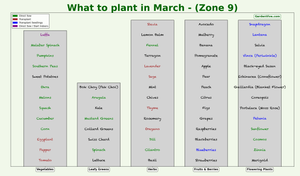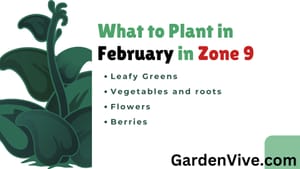
As promised, here I am with another fresh article on the December planting guide for Zone 9. We often get confused while choosing what to plant at a specific time of the year. I started creating planting charts and calendars for particular months to make it easier for you. In this article, you will find what to plant in December in Zone 9.
Those who are new to my blog are suggested to check the November Planting Guide - Zone 9 - Here I have mentioned the regions that fall under Zone 9. ( To check who can follow this planting guide)
I understand that Zone 9 can vary across regions in terms of climate and soil conditions. Therefore, I’m focusing on the most common plants that can perform well across all areas within Zone 9.
Zone 9 is not that much cold in December if you compare it with other growing zones (lower than 9). Due to the mild cold, we have a lot of options to plant at this time of the year.
Plant types that I am going to cover (Click to expand)
- Leafy Greens
- Vegetables and Roots
- Flowering Plants
- Fruit Trees and Berries
- Herbs
As there is a chance of frost in December in Zone 9, I am adding a column for frost care beside each plant name.
Tip: If you don't want to miss any information from the chart scroll the table side-wise on small screen devices.
Leafy greens to plant in December in Zone 9
I have added planting method suggestions, variety suggestions, frost care (if needed), spacing when planting, harvesting time in days, and sunlight for each plant.
Those who are not willing to invest much time in caring for their plants can read the maintenance difficulty from this chart.
| Plant Name | Planting Method | Variety Suggestion | Frost Care | Spacing | Harvesting Time (days) | Sunlight | Maintenance Difficulty |
|---|---|---|---|---|---|---|---|
| Lettuce | Direct Sow or Transplant | Romaine, Butterhead | Use Row Covers | 8–12 inches | 45–60 | Full Sun to Partial Shade | Easy |
| Spinach | Direct Sow | Bloomsdale, Tyee | Mulch for Insulation | 6 inches | 40–50 | Full Sun | Moderate |
| Kale | Direct Sow or Transplant | Curly, Lacinato | Tolerates Light Frost | 12–18 inches | 50–70 | Full Sun | Easy |
| Swiss Chard | Direct Sow or Transplant | Bright Lights, Fordhook Giant | Use Frost Cloth | 12–18 inches | 50–60 | Full Sun to Partial Shade | Easy |
| Mustard Greens | Direct Sow | Southern Giant Curled | Use Mulch | 6–12 inches | 30–40 | Full Sun | Moderate |
| Arugula | Direct Sow | Rocket, Astro | Light Frost Tolerant | 4–6 inches | 20–40 | Full Sun to Partial Shade | Easy |
| Collard Greens | Direct Sow or Transplant | Georgia Southern, Vates | Mulch and Cover | 18–24 inches | 55–70 | Full Sun | Easy |
| Endive | Direct Sow | Frisée, Broad-leaf | Row Covers | 8–12 inches | 45–60 | Full Sun to Partial Shade | Moderate |
| Bok Choy | Direct Sow or Transplant | Tatsoi, Joi Choi | Light Frost Tolerant | 6–8 inches | 30–50 | Full Sun to Partial Shade | Easy |
| Watercress | Transplant or Water-Based | Aquatic, Nasturtium | Protect from Frost | 4–6 inches | 20–30 | Partial Shade | Moderate |

Roots and Vegetables - Zone 9 - December
| Plant Name | Planting Method | Variety Suggestion | Frost Care | Spacing | Harvesting Time (days) | Sunlight | Maintenance Difficulty |
|---|---|---|---|---|---|---|---|
| Carrots | Direct Sow | Nantes, Danvers | Mulch for Insulation | 2–3 inches | 70–80 | Full Sun | Easy |
| Beets | Direct Sow | Detroit Dark Red, Golden | Mulch for Insulation | 3–4 inches | 50–65 | Full Sun to Partial Shade | Moderate |
| Radishes | Direct Sow | Cherry Belle, French Breakfast | Light Frost Tolerant | 2 inches | 25–35 | Full Sun | Easy |
| Turnips | Direct Sow | Purple Top, Golden Ball | Mulch for Frost Protection | 4–6 inches | 30–60 | Full Sun | Easy |
| Parsnips | Direct Sow | Hollow Crown, Harris Model | Mulch for Insulation | 3–4 inches | 95–120 | Full Sun | Moderate |
| Garlic | Plant Cloves | Softneck, Hardneck | Mulch for Winter | 6 inches | 180–240 | Full Sun | Easy |
| Onions | Transplant or Sets | Yellow Granex, Red Burgundy | Use Frost Cloth | 4–6 inches | 100–120 | Full Sun | Moderate |
| Shallots | Plant Bulbs | French Grey, Dutch Yellow | Mulch for Insulation | 6 inches | 90–120 | Full Sun | Moderate |
| Peas | Direct Sow | Snow Peas, Sugar Snap | Light Frost Tolerant | 2–3 inches | 50–70 | Full Sun to Partial Shade | Easy |
| Fennel | Direct Sow | Florence, Bronze | Mulch for Insulation | 6–12 inches | 90–120 | Full Sun | Moderate |
If you are shocked seeing the spacing, don't worry they are linear spacing. You should provide 12 inches of spacing between two rows.
There are some vegetables that we can also consume as leafy greens.

Those who have already planted ginger should read: Can I leave my ginger in the ground through the winter?
Flowering plants
December is really a preferable time to plant a lot of flowering plants in Zone 9. Let's check the chart.
| Plant Name | Flower Colors | Fragrance | Frost Care | Spacing | Flowering Time (days) | Sunlight | Maintenance Difficulty | Annual/Perennial |
|---|---|---|---|---|---|---|---|---|
| Pansies | Various (Purple, Yellow, White, Red) | Mild | Light Frost Tolerant | 8–12 inches | 60–70 | Full Sun to Partial Shade | Easy | Annual |
| Primroses | Various (Pink, Yellow, Red, White) | Light | Cold Hardy | 6–8 inches | 50–60 | Partial Shade | Moderate | Perennial |
| Snapdragons | Pink, Yellow, Red, White, Purple | Moderate | Frost Tolerant | 8–10 inches | 70–80 | Full Sun | Moderate | Annual |
| Calendulas | Yellow, Orange | Light | Frost Tolerant | 6–8 inches | 50–60 | Full Sun | Easy | Annual |
| Sweet Alyssum | White, Purple, Pink | Fragrant | Cold Hardy | 4–6 inches | 40–50 | Full Sun to Partial Shade | Easy | Annual |
| Violas | Blue, Purple, Yellow, White | Mild | Light Frost Tolerant | 6–8 inches | 60–70 | Full Sun to Partial Shade | Easy | Perennial |
| Cinerarias | Blue, Pink, Purple, White | Mild | Frost Tolerant | 8–12 inches | 70–80 | Partial Shade | Moderate | Annual |
| Stocks | White, Pink, Red, Purple | Fragrant | Frost Tolerant | 6–8 inches | 70–80 | Full Sun | Moderate | Annual |
| Hellebores | White, Pink, Purple, Green | Light | Cold Hardy | 12–18 inches | 90–120 | Partial Shade | Moderate | Perennial |
| Geraniums | Red, Pink, White, Purple | Light | Frost Sensitive | 12 inches | 70–90 | Full Sun | Moderate | Perennial |
I have not mentioned all the flowering plants; there are a lot more.
Those who are already growing Plumeria it's time to take winter care for Plumeria.
Tip: How to grow calendula in pot. (This is also known as pot marigold)
Fruit trees and berries
| Plant Name | Max Height | Harvesting Season | Variety Suggestions |
|---|---|---|---|
| Apple Tree | 12–20 feet | Late Summer to Fall | Fuji, Granny Smith, Gala |
| Peach Tree | 15–25 feet | Summer | Redhaven, Elberta, Clingstone |
| Cherry Tree | 15–25 feet | Late Spring to Early Summer | Bing, Rainier, Montmorency |
| Blueberry Bush | 2–6 feet | Late Spring to Early Summer | Legacy, Patriot, Bluecrop |
| Strawberry Plant | 1–2 feet | Spring to Early Summer | June-bearing, Ever-bearing, Day-neutral |
| Raspberry Bush | 3–6 feet | Summer to Fall | Heritage, Red Latham, Fallgold |
| Fig Tree | 10–15 feet | Late Summer to Fall | Black Mission, Kadota, Adriatic |
| Pear Tree | 15–20 feet | Late Summer to Fall | Bartlett, Anjou, Bosc |
| Plum Tree | 10–15 feet | Summer | Santa Rosa, Methley, Stanley |
| Blackberry Bush | 3–6 feet | Summer to Fall | Navaho, Marion, Boysenberry |
| Apricot Tree | 10–15 feet | Spring | Tilton, Moorpark, Katy |
You can plant these in winter. But here's a friendly tip:
Try to plant fruit trees in their individual growing season. Most of the plants will perform good if planted in spring.
Those who are growing apple trees, need to understand the necessity of the pollinator apple varieties that are suitable for any specific apple variety.
Check: Pollination chart for apple trees.
Herbs
| Plant Name | Spacing | Maintenance Difficulty | Annual or Perennial |
|---|---|---|---|
| Basil | 12–18 inches | Easy | Annual |
| Thyme | 6–12 inches | Moderate | Perennial |
| Oregano | 8–12 inches | Easy | Perennial |
| Parsley | 6–8 inches | Moderate | Biennial (often grown as an annual) |
| Mint | 18–24 inches | Easy | Perennial |
| Chives | 6–12 inches | Easy | Perennial |
| Cilantro | 6–8 inches | Easy | Annual |
| Rosemary | 12–18 inches | Moderate | Perennial |
| Lavender | 18–24 inches | Moderate | Perennial |
| Sage | 12–18 inches | Moderate | Perennial |
| Marjoram | 12–18 inches | Moderate | Perennial |
| Arugula | 6–8 inches | Easy | Annual |
| Lovage | 18–24 inches | Moderate | Perennial |
| Tarragon | 12–18 inches | Moderate | Perennial |
| Fennel | 12–18 inches | Moderate | Perennial |
I tried growing coriander and they performed well. You can give it a try.

Growing Lavender in Zone 9 is not as hard as you think. Just check my guidelines on how to grow lavender in Zone 9.
If you feel you just found a useful resource, subscribe to this site and share it with your friends. It's free for you! and it will motivate me to write more on Zone 9 Gardening.






